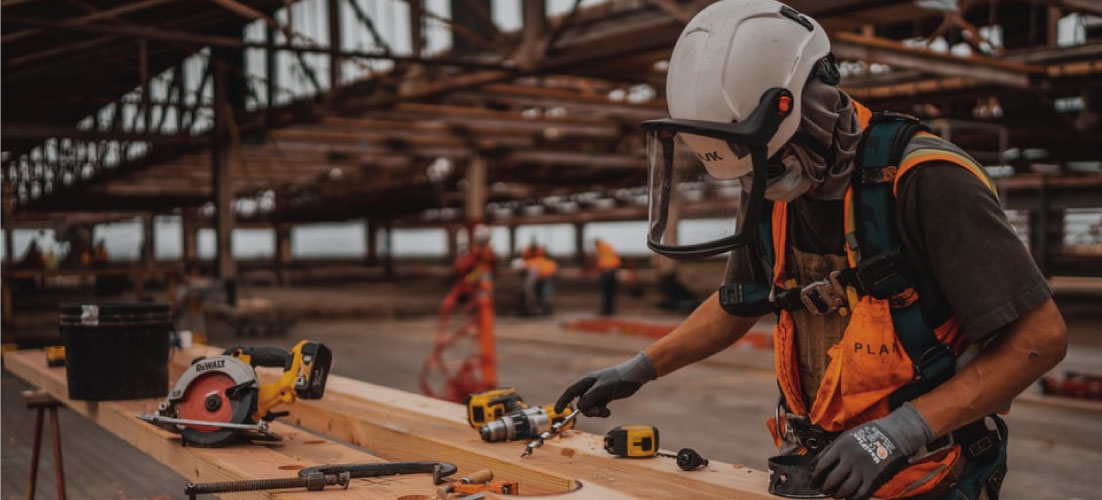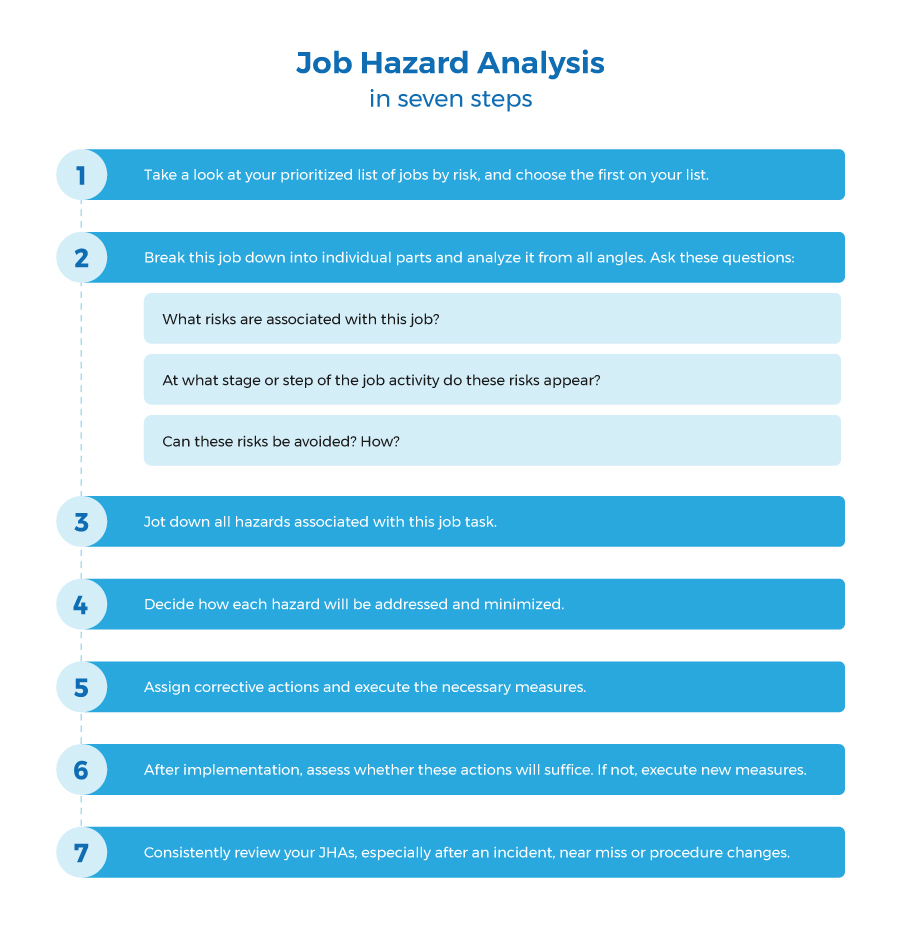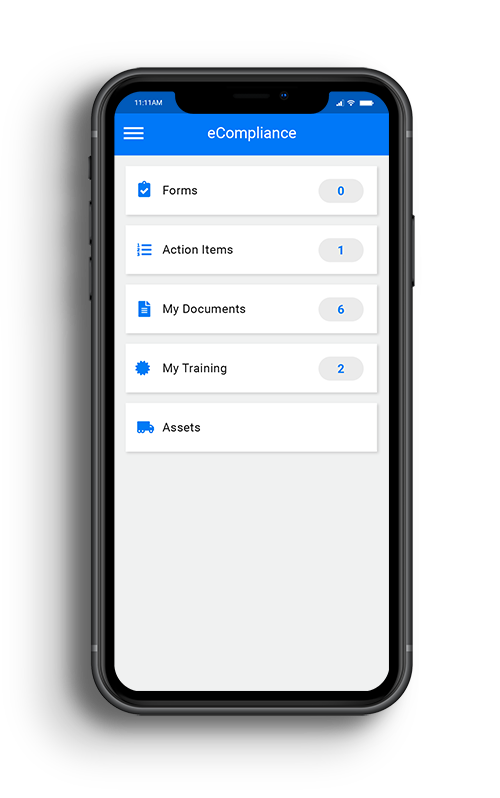
Share this Post
PUBLISHED
February 2, 2021
READ TIME
5 Minutes
WRITTEN BY
![]() Dina Adlouni
Dina Adlouni
Dina is the resident Content Writer at EcoOnline North America . When she’s not writing about health and safety, you’ll find her enjoying a cup of tea while watching her favorite sitcom.
Identifying hazards is one of the most crucial elements of any safety professional’s job. What’s the best way to conduct a thorough hazard assessment? With many different techniques available, EHS professionals choose Job Hazard Analysis (JHA) as a key process to stay proactive. A JHA will give you 360 insight into all hazards on-site and help you do everything from identifying the right hazards, to doing what is necessary to implement the controls needed to keep your people safe.
What is a Job Hazard Analysis
Let’s start from the very beginning. What exactly is a job hazard analysis? Like the name suggestions, a job hazard analysis is a procedure to help you effectively analyze hazards on-site. With a JHA, you are able to dissect all jobs and activities on-site into separate elements to identify any hazards or risks associated with that particular job or activity. Once you are able to associate each individual hazard with its respective job or activity, you can then work to reduce or eliminate it. This is done in many ways from implementing specific technological controls to using the right forms of PPE. Because it’s not always easy to completely eliminate a hazard, it’s important to use every method necessary to give your people the right tools if they must be in close contact with it. With a JHA, protecting the workforce and preventing any injuries or illnesses on-site can be done with ease.
What Types of Jobs Should Receive a JHA?
All jobs should receive a JHA; however, there are always jobs which are more dangerous than others. Jobs where there is no room for error. It’s important to start identifying these first when you conduct your JHA.
When prioritizing, focus on jobs that:
- Have high injury and illness rates, not only at your site but within the industry as well
- Have high near-miss rates
- Have no room for mistakes
- Have a high degree of complexity
Is JHA Safety Required for OSHA?
In short: yes and no. Though the Occupational Safety and Health Administration (OSHA) doesn’t explicitly state that JHA safety is mandatory, it does state hazard assessments are required under OSHA 29 CFR Part 1910.132 in order to pick the right PPE for specific job tasks. To do this effectively, consider a JHA to thoroughly identify all hazards that may arise on the job. Once all hazards are identified, decide the necessary means to reduce any risk using proper PPE for hazards that are inescapable.
How to Begin a Job Hazard Analysis
To conduct a proper Job Hazard Analysis, you must prepare. Get yourself ready with these key tips:
1. Take a Deep Dive into Previous TRIF, TRIR, and DART records
It’s important to look back and analyze TRIF, TRIR, and DART rates per location. The answer usually lies within the data, so take a look at which roles and activities were most dangerous and had the highest amount of risk to your workforce. Once these jobs are identified, prioritize them in order of most dangerous to least dangerous. Once all high-risk jobs are chosen, move on to other roles on-site.
2. Make sure all jobs and duties are aligned with COR and OSHA standards
No matter where your site may be, it’s vital all roles and jobs duties are aligned with federal and provincial standards. Make sure you are up to date with the latest standards set out by the Occupational Safety and Health Administration (OSHA) with OSHA compliant software, if you are within the United States, or the Certificate of Recognition (COR) if you are located anywhere in Canada.
3. Get Front-Line Worker Buy-in
With all high-risk jobs properly identified, it’s time to get frontline buy-in. Who better to get onboard than those who are in the thick of it day in and day out? Empower your front-line workforce by letting them know their voice and involvement matters. By being in the center of all, your front-line workers will have great insight into what really goes on a day-to-day basis to uncover risks which may seem hidden.
Job Hazard Analysis Steps
Now that you’re fully prepared for your JHA, it’s time to execute. Follow these job hazard analysis steps to reduce all possible risks on-site.

A job hazard analysis is an opportunity for continuous improvement to not only eliminate hazards on-site and protect your people, but to improve your safety culture and drive performance. It’s time to elevate the standard of safety at your organization.
Find out how EcoOnline eCompliance can help simplify your JHA with our user-friendly software! Fill out the form below and one of our safety experts will be in touch.
Resources:
- https://safesitehq.com/job-hazard-analysis-jha/
- https://www.safetyworksmaine.gov/safe_workplace/safety_management/hazard_analysis.html
- https://ehs.ncsu.edu/health-safety/occupational-safety/job-hazard-analysis-jha/
- https://public-library.safetyculture.io/products/job-hazard-analysis-jha
- https://safetyskills.com/job-hazard-analysis/
- https://www.convergencetraining.com/blog/what-is-a-jha
Learn How You Can Get eCompliance
Complete this form and one of our safety experts will be in touch.

